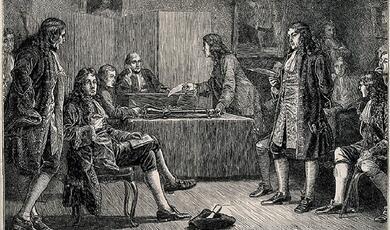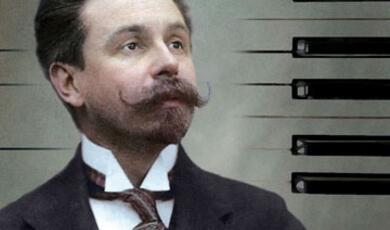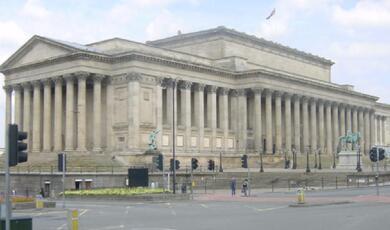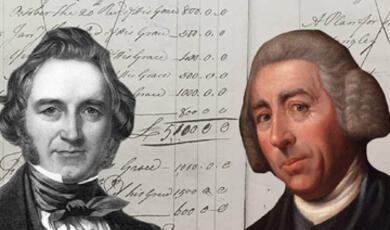The Reform Club: Architecture and the birth of popular government
Share
- Details
- Text
- Audio
- Downloads
- Extra Reading
Professor Peter Marsh, Honorary Professor of History at the University of Birmingham, and Mr Paul Vonberg, Architect.
Lecture followed by Reception.
Download Text
THE REFORM CLUB: ARCHITECTURE AND THE BIRTH OF POPULAR GOVERNMENT
Peter Marsh
It is a great honour to be asked to provide a short historical introduction to the existing work that Paul Vonberg is doing, designing and carrying through the renewal of the Reform Club building.
The Reform Club, the building, is a great stage in the theatre of politics. It often reminds me when I am there of the opera houses built at the end of the Eighteenth or beginning of the Nineteenth Century to bring the affluent middle classes into what had hitherto been an aristocratic preserve. In the Great Hall of the Reform Club, merchants from Manchester could literally rub shoulders with Whig Dukes. No one who enters the Reform Club can mistake it for a setting for democracy.
The Reform Club was founded as much to control as to promote the popular form of government to which the great Reform Act of 1832 gave rise. The great Reform Act was breathtakingly radical for its time, and it was breathtakingly radical in order to be the last Reform Act. Yet in no sense that it was the first - to think of that would be failure. It widened the franchise to embrace the whole of the propertied middle class, in an attempt to resist the demands of the Birmingham political union and leader of the Chartists for the enfranchisement of all adult males - no one was so daring as to think of women. I often think as I walk down New Hall Hill in Birmingham that is where the tens of thousands gathered in the autumn of 1831 and really intimidated Parliament into passing a radical reform act. They wanted more than they got.
The founders of the Reform Club were the men responsible for the Reform Act. When you go into the Reform Club, you will see high up on the left Earl Grey, who was the Whig Prime Minister, that carried through the Reform Act. There he is, benignly overseeing the Reform Club. The founders of the Reform Club hoped at least to slow down, if not to stop, the march toward democracy. They shuddered at the handiwork of democracy, which they had seen in France, in revolutionary France, in the 1890s. That was back a bit, but in the 1830s, they were seeing the handiwork of democracy also in Jacksonian America. Andrew Jackson had been elected President of the United States in 1828, and immediately introduced, as a measure of democratisation, a spoils system which threw out of office all the well-qualified civil servants and installed in their place his partisan support, the less qualified the better for his purposes, because these were to be the real people. The British governing classes were horrified - Whig as well as Tory - horrified by the democracy that they saw as they were debating the Reform Act in 1832, which is indeed the year in which Jackson was re-elected.
The Reform Club Building accordingly furnished to the newly formed Liberal Party in Parliament, and among the enlarged electorate. I will talk about the formation of the Liberal Party in a moment. But the facilities that the Club established were a large central hall where the Parliamentary Liberal Party could assemble, grand dining rooms, rooms for smaller meetings of Party members, and - this is very important - office space in the basement for the creation of a nationwide constituency organisation to register the Party's supporters as qualified under the terms of the 1983 Reform Act. In order to get a properties middle class electorate, you had to establish that they owned the requisite amount of property, and that involved, inevitably, solicitors. They would go over the electoral register, making sure that all the good Liberal supporters were kept on, and all of the benighted Conservatives were kicked off. That organisation was going on in the basement of the Reform Club, and a Library, a wonderful Library - still a wonderful Library - to inform and nourish parliamentary debate.
Now, the Reform Club served these purposes well during the middle third of the Nineteenth Century, when the Liberal Party was nearly always in power. The Liberal Party was an alliance of aristocratic Whigs and the likes of Lord Grey, middle class merchants, members of the professions, and moderate Irish Nationalists. They governed Britain and the British Empire for most of the middle third of the Nineteenth Century.
As a Canadian, I am continually reminded when I am at the Club of the ways in which those imperial responsibilities challenged and eventually shattered the Liberal alliance. Along, again, the left hand wall of the upper gallery of the Reform Club, there are two portraits: one of Lord Durham; and the other one of Lord Sidnam of Toronto, which is my home town. These are portraits that commemorate, that honour their work in bringing about what was called responsible government to upper and lower Canada. Responsible government simply meant that the executive of these colonies would have to be responsible to the majority of an elected legislature, and the elected legislature, in upper and lower Canada, would be all the adult males. So it was a genuinely democratic assembly that Lord Durham and Sidnam of Toronto were bringing into effect.
However, the legislatures in both upper and lower Canada, challenged the Liberal assumptions of the politicians who had given them responsible government. They challenged it by immediately exercising their powers to impose protective tariffs against the goods coming in from the mother country. Now, if there was anything dearer to Liberals than a propertied middle class electorate, it was free trade. It is a classic question: what do you do when liberal institutions adopt illiberal policies?
These radical Whigs were liberal enough to say, 'Well, the Canadians are benighted, they are wrong, but we have got to let them, we hope, find out the errors of their ways.' Canadians are very slow to do that. That was a real test of Liberal principles, to which the leaders of the Liberal Party rose triumphantly.
But the Reform Club was not designed to cope with democracy on that Canadian scale, certainly not in Britain. The Liberal Party, and hence the Club, failed to accommodate themselves to the further enlargements of the electorate in the Second and Third Reform Acts of 1867 and 1884/5, which enfranchised a substantial proportion of the working class. Those acts unleashed electoral forces and passions which tore the Liberal Party, and hence the Reform Club, apart.
They were epitomised by Joseph Chamberlain, not a landed gentleman - no one ever mistook him for that - but a screw manufacturer from metal manufacturing Birmingham. He took to public life in order, with some considerable high principle of a sort, to ensure the wealth that he got from his labour, as a big factory-owning capitalist manufacturer. So he wanted to protect that wealth by ensuring that its benefits were widely spread, but these are not the kinds of issues for which the Whigs of the 1830s, '40s, and '50s had much interest or capacity. Chamberlain, the formation of the National Liberal Party (again in Birmingham) in 1877, the radical programme that Joseph Chamberlain issued in 1883/84, and his unauthorised programme of 1884/5 really shook the Liberal Alliance badly. In the spring of 1884, he used the word 'ransom' - 'What ransom will property pay to ensure the perpetuation of its privileges?' - a word that shook the Whig assumptions of the Reform Club to its foundations.
But it was the simultaneous challenge from Ireland that irrevocably split the Liberal Party and deprived the Reform Club of its political purpose. As you enter the Reform Club, to me, the strangest portrait in the whole building is on your immediate left, and it is Daniel O'Connell, the Liberator, there with his green sash. He was the most restless, unsettling of the founders of the Reform Club, but he was peace itself compared to the man who took over the leadership of the Irish in Parliament in the middle of the 1870s, Charles Stuart Parnell. It was he, with his uncompromising version of home rule that began the earthquake. In order to calm down the earthquake - never a very good tactic - Gladstone offered to give a very large measure of home rule to Ireland, and it was that that split the Liberal Party and split the Reform Club, depriving it of its political purpose.
The Reform Club still served political purposes after its disruption, but those purposes were no longer clear. I came recently upon a bit of information about the Reform Club. In June of 1940 Neville Chamberlain had been thrown out as Prime Minister but still retained an important position really as the right hand man of Winston Churchill in the new Government. It was in the Reform Club that three men - Harold Macmillan, Leo Amery and Robert Boothby met, Conservatives all 'met nightly in June of 1940, plotting to see what they could do to throw Neville Chamberlain out of office completely. He was kept in, interestingly, at the insistence of Churchill.
But that is a murky episode far from the broad sunny uplands of the middle of the Nineteenth Century, which were the glory days of the building about which Paul Vonberg is now going to speak.
Paul Vonberg
**Why would a group of men determined to give 'power to the people' build themselves a socking great palace like this?
Because, as we've heard, the aims of the Club's founders, who were also the founders of the 'Great' Reform Act of 1832, were not quite as altruistic as one might have imagined, or as history has generally presented them.
There were matters of mixed motives, to say the least?
And what, you might be wondering, does the architecture of the Reform Club have to do with that? Is not the design of the building simply something that was controlled by the architect, Charles Barry, later Sir Charles Barry and most famous for designing our Houses of Parliament?
Of course, Barry had much to do with it but, in the end, clients get the building they want - or think they want? or are persuaded to want? or fear the consequences of saying they don't want?
And in that twilight zone between want, uncertainty and fear, buildings get designed in certain ways, become certain sorts of buildings which then remain with the rest of us for years and years.
Every building inherently reflects the aims and attitudes of those who commissioned it. Buildings obey the rules of 'body language'. They cannot help but tell the truth.
The Reform Club is an excellent example. It is an excellent building?
You don't know it?
*It stands on the South side of Pall Mall, some hundred and fifty yards west of Trafalgar Square. Like all the traditional Clubs of St James's, it doesn't advertise itself (that for a start is quite telling) but resides behind the simple number 104.
*Its exterior, of Portland stone, is grey and imposing, rather forbidding even.
*But beneath a wonderfully rich cornice of huge proportions *rows of windows arraign themselves solemnly across the façade, *above a central door case of noble scale *and gorgeous detail.
*Within, the centre of the building, the Saloon, is day lit from above. What happy place for members to snooze or chat away the afternoon. *Fabulous galleries, rich in marble, ornate plaster and sumptuous carpets surround the central space.
*The founders of the Club look down on the galleries. Meanwhile, from those galleries, *huge doors in birds eye maple or oak open onto room after room, *the Coffee Room, *Library, *Smoking Room, many with their original furniture, all with ornate ceilings, intimate lighting and one of the finest private collections of books in the capital.
* Those few rooms which had been spoiled in the twentieth century, *it has been my privilege to rebuild, making from the unfortunate Card Room a room more fitting to the rest of the Club, *gilded and *stencilled where before was only brown and red gloss paint.
*From the so called Mezzanine Dining Room, *we made the more elegant Garden Room *.
*Above, two floors of chambers provide overnight accommodation. *The upper of those floors is newly built, while (a bit of a sore point) *one of the staircases between the two floors is nearly built, hence no photograph, only my drawing.
*The colours and materials chosen by Barry (and followed by me) are rich, dark and refined, the Green and Black of the mid nineteenth century. This scagliola, an imitation marble, is more prestigious now than the real thing. This is a building where solidity *and transparency are wonderfully balanced.
*Behind it, an oasis of a garden, sunny and secluded *with ancient London planes, completes this heavenly place.
*Without doubt, the Reform Club is a good building. It has served its purpose, its original purpose, for over one hundred and sixty years, which is more than many buildings manage. It also feels good to be in. And as with a good wine, a good concerto or a good book, analysis is not a prerequisite of appreciating quality.
*Nevertheless, analysis is what you are going to get.
Not so much a technical analysis of the building's form or proportion but, as I hinted at the beginning, analysis of the relationship between the building's form and its meaning, between 'how the building is' and 'what the building says'. An exploration of the 'body language' of the Reform Club.
We are going to look at some very straightforward characteristics of the building, perhaps ones that are normally taken for granted, which normally attract little remark, characteristics such as symmetry, classicism, ornamentation, plan form and the relationship of the building to the city. We are going to see whether those characteristics are ones which one might expect of a building put up by the midwifes of popular government.
I think we may find that the building speaks surprisingly clearly the aims and attitudes of its founders.
And beyond that, as we consider each issue (there are seven) I thought it might be interesting to see where those issues are today, where ideas such as symmetry and classicism lie in the present architecture of England.
For if my thesis is correct, that the Reform Club's building can tell us about politics and society in the 1830's, then perhaps we can learn something from today's architecture about politics and society in 2007. We might even gain a little insight, purely from the architecture, into the state of popular government, one hundred and seventy-five years after its birth?
*The Reform Club is symmetrical, both in the original sense of being well balanced but also in the more commonly used sense of being bilaterally symmetrical or 'mirrored' around a central line. *It is symmetrical at the front. *and symmetrical at the back. So what?
It's not entirely surprising; the building was modelled on a palazzo in Rome, *the Palazzo Farnese, which is itself symmetrical. The Palazzo Farnese had been visited by Barry when a young man. The story of how its design developed into the Reform Club is another fascinating tale, which a number of you has heard.
What then is the significance of this symmetry? To me it suggests confidence, a sort of 'arms folded', 'we've arrived' message, balanced, solid, reliable and respectable. It often strikes me as interesting that the Reform is so symmetrical while its *neighbour, also by Barry, the Traveller's Club, is emphatically assymetrical.
Now you may say that that is because the site for the Travellers' was smaller and there was no room to put in a central entrance without cramping the accommodation. That may be true, of course, but might it not also be true that travellers are inherently 'passing through'? As we know, it is better to travel than to arrive, but for the Reformers arriving was everything
Clients get the buildings they want, etc, etc. Symmetry felt right for the Reform because its founders wanted to tell the world that they were now enfranchised. They were where it was at.
But symmetry runs much deeper than that. It is born of the human body.
*We are often symmetrical in the way we use our hands, *or don't use our hands, *in the ways we sit in relationship to one another.
*Our whole bodies are bilaterally symmetrical, as are our faces *beautiful, *young *and old.
*Symmetry has been a significant part of architecture for centuries. *In England, it has dominated much of our housing, both great *and small, *nineteenth and *twentieth century, *in a variety of styles.
One might expect, perhaps, that a country proud of its popular government would continue to embrace an architecture which reflected the actions and bodies of its people. Yet, curiously, the majority of modern buildings, at least those designed by architects, seem to be determinedly assymetrical * *. Whether large *or small.
Don't misunderstand me; I am not saying that assymetrical buildings are bad buildings. *This one seems to me to be a rather beautiful one. It just seems odd that the very human characteristic of bilateral symmetry should, in a democratic society, have been so 'sidelined', left only to *developers and *self builders.
Why that might have been, we shall discover in a moment.
*The second of my simple characteristics is that the Reform Club is elevated. *It is raised up above the pavement. *Steps must be mounted to gain entrance. The whole front is set up and back, behind a heavy stone balustrade and across a deep area which lights the basement.
*At the back of the building, the same arrangement prevailed. But in about 1995 the Club sought consents to bridge across the area and gain access to the garden, a garden which until then they had only been able to gaze upon. In the discussions with English Heritage about whether such a change was acceptable, the Club was described as 'deliberately aloof'. I never fully understood why it should be aloof until I heard Peter Marsh this evening. Of course, it was aloof because its members did not want to admit all comers. They might have been supporters of popular government, of extending the franchise, but only so far?
*We built the steps; they were completed in 2003, after *making a bit of a mess in the meantime. *The Club's relationship with the garden was transformed.
Of course, the Club is not the only building to have raised itself up. Buildings have been elevated above the surface of the ground for centuries, for practical reasons, *to keep the rats away from the grain, or *to keep above the flood water; an uncomfortably topical issue. But houses have also been raised to make them seem more important, *a little, in the case of Mies van der Rohe's Farnsworth House, *a lot, in the case of Le Corbusier's Villa Savoye, or *an amount of a different order entirely, in the case of this Case Study House in, or rather above, Los Angeles.
The desire of human beings to raise themselves up is natural, * whether to make themselves more visible, *or just taller, *or just for the hell of it.
But in architecture it seems to me that it is a tendency to watch carefully. There are some interesting paradoxes. While we now have extensive legislation in favour of level or ramped access, which seems to me to be an essentially democratic move (and, interestingly, a difficult problem to solve at the Reform), we seem to be experiencing no abatement at all in the construction of high rise buildings.
*And while stacking people up to work may be ok, *stacking them up because they can't afford to live on the ground seems to me to be a deeply suspect concept in any democracy.
Let's just look at those two again. *On the face of it so similar, how different they really are. One speaks of power and control while the other * speaks of powerlessness and alienation. If your accommodation is elevated, chances are someone is underneath you. Is that an architecture one would expect to come with the rise of popular government?
*Back to the Reform for a moment - The contrast with the Palazzo Farnese is particularly fascinating. So similar in many ways to the Reform, the Farnese on the left, the Reform on the right, the relationship between the two buildings and the ground is fundamentally different. Whereas the Club, as we have seen, is raised up and aloof, *the Palazzo is set down on the ground, surrounded by a bench, on which sat the supporters, in a feudal sense, of the Farnese family.
If it wasn't for the chewing gum, the beer bottles and the syringes, how wonderful it would be for any institution to be able to welcome its supporters, customers or employees, day and night, by providing them with a bench.
*Thirdly, the Reform Club is classical.
Now, having the privilege of being the architect with care of the Club I could, as you might imagine, ramble on about classicism for hours. I won't, I promise.
But what does classical mean? And what has it got to do with popular government?
*At one level, it just means the building has 'orders', you know, those columns *with the different capitals, and *pediments, the triangular or curved bits on the top, *like the temples of ancient Greece and Rome.
*As an aside, when the Club needed a new roof, *we took away a leaking slate roof and made the Club even more Roman *by adding an Italian terracotta tiled roof. It was a fascinating exercise, *both in terms of the geometry, *and the production**.
The results are pleasing, and so far effective* Have a look next time you are in St James's Square.
But what about this classical thing? For the founders of the Reform Club, classicism would have lent their building an air of respectability, of scholarship, would have suggested a connection with the ancient civilisations, one of which at least was fairly democratic.
Classicism would also have provided Barry with a sensitivity to the human scale. Inherent within the idea of classicism is the idea that a column represents a human being and that each column, and each other element of the building, has its part to play in a coordinated hierarchy in which the whole is more than the sum of the parts, in which the small has a place within the large.
Is that not a wonderful model for a democratic state? Could not all buildings reassure us that we have a role to play and that all our efforts can achieve something worthwhile which we could not achieve alone?
Margaret Thatcher's phrase about there being no such thing as society springs to mind... but there, I must stick to the architecture.
Let us be clear that classical architecture is not inherently a political statement.
It has been used by all sorts of governments, organisations and individuals.
But something has gone awry.
For centuries, the so called 'rules' of classicism were moulded and interpreted by the individual imaginations of the architect and by the spirit of the age.
*Filippo Brunellschi's classicism in fifteenth century Florence,*
*was quite different from Sir John Soane's in early nineteenth century England,*
*from Sigurd Lewerentz's classicism in early twentieth century Sweden,*
*or from Gunnar Asplund's, again in Sweden.
Each of them created buildings which were classical and new, grand and yet human in scale.
*As late as 1934, on a hill in N6, Berthold Lubetkin was putting up a building which combined classicism with a modernist sensibility and his own invention. Highpoint 2. Don't confuse it with Her Majesty's Prison called Highpoint; this was, in the words of Henry Russell Hitchcock, 'the finest middle class housing project in the world'.
But, at exactly the same time, something was going badly wrong for classicism, in Germany.
*It was this, the work of Albert Speer, Hitler's architect. Look carefully at the gateway in the bottom right. *It's this, the Brandenburg Gate...
Immediately, classical architecture became associated with this, *with power, with control, with vast scale, with the very opposite of popular government.
And then, as a reaction, in England at least, classicism became 'persona non grata'. Symmetry went with it.
My own feeling is that classicism has yet to recover from this association?
In the post war years, it was little seen, certainly not in association with the architectural programmes of the welfare state.
*In the 1980's, there were attempts to revive classical architecture as a sort of joke. The joke was called 'Post-Modern Classicism'. The most notable result in this country, not a hundred yards from the Reform Club, *was the Sainsbury Wing of the National Gallery. Not a bad building in many ways, but its use of classical motifs is self-conscious and unsubtle; amusing on first sight, but that is all.
*Meanwhile, architects such as Quinlan Terry continue manfully to design in an eighteenth century classical style, bringing a breathtaking mastery of detail but little sense of scale or propriety, let alone an individual invention. Look around Downing College when next you are in Cambridge.
What has made things worse is that those architects who have held on to classicism tend to be of the far right.
An architecture that could be appropriate to a multi-racial democracy has become branded. Most architects regard classicism with deep suspicion, even embarrassment.
But someone serious, soon, will rehabilitate classicism. Someone will bring to it the benefits of light and airiness, and crispness, those benefits which modernism has brought us.
*I noticed the earliest awakenings of it the other day in Paternoster Square, in a building by an old tutor of mine, Eric Parry. I'm sure he would shudder at the thought of being described as a classicist.
*Fourthly, the Reform Club is ornamented. *You have seen the carved Portland stone around the entrance. *Within, there is a fabulous pavement * *, breathtaking joinery and plasterwork, *carved alabaster busts and so on.
The founders of the Club were able to build in such an elaborate way for the simple reason that labour then was relatively cheap. One might argue that such employment was an expression of the power of the middle class founders over the working class craftsmen, whose enfranchisement they so feared.
Paradoxically, the spread of popular government and the parallel growth of the power of the working class have seen the virtual demise of such ornament as the workforce dwindled and rates of pay increased.
I see no likelihood that the level of ornament seen at the Club will return in any general sense.
Such skills are still available of course, but only at a very high price, *as the Club discovered when we rebuilt the glass roof of the Saloon * *,
replacing about a third of the seven hundred and seventy glass lozenges.
*It was the same story when we built new birds eye maple bookcases in the Card Room* *, *decorated the ceiling in its original colour scheme, or, recently, *recarved a number of the stone dolphins which adorn the corona of the main cornice.
A democratic government might or might not wish to encourage such works; it is hard to see how they might ever be inexpensive again, unless they are machine produced, which gives results of a very different, and inferior, quality.
*Fifthly, The Reform Club is hi-tech, highly technical, in part at least.
*That roof, even in 1841, was highly technical, being made of cast iron sections, bolted together and supporting those seven hundred and seventy *curved, cut glass, or rather lead crystal, lozenges in eleven different sizes, each faceted like a whisky tumbler*.
Hi-tech.
Not wishing to be confused with hi-tech crime, hi-tech weapons or hi-tech horror movies, what do I mean by the architectural use of the word 'hi-tech'?
I even saw a recent headline, 'Hi tech toilet swallows woman'!
As far as architecture is concerned, I mean a building where the structure is not concealed, *as has been conventional for much of the history of western architecture.
*In a hi-tech building, the structure is exposed to view. The structure is very often of metal, almost invariably made off site, to close tolerances, and brings with it a certain mechanistic thrill, but also problems when it goes wrong.
This is the Bibliotheque St Genevieve in Paris by Henri Labrouste, finished only a few years after the Reform. Notice the exposed iron arches and columns. * This is the Bibliotheque Nationale, of 1868.
And of course, the tendency to expose structure has been popular more recently too. *This is Richard Rogers Lloyd's Building in the City, opened in 1986.
*This is Marks Barfield's London Eye, opened around the time of the millennium
*and this is Lord Foster's roof over the Great Court at the British Museum.
The similarity between its roof *and that of the Reform Club is striking. *Indeed Foster's more recent St Mary Axe building, popularly known as the Gherkin, is also very like.
Does this have anything to do with the birth of popular government, or with politics in general?
Only in so far as the use of new technologies of this sort is heavily dependent on a manufacturing economy. They are essentially machines within buildings and their production is far from the hand craft skills which encourage pride in their producers. Impossible without the industrial revolution, the roof of the Saloon was a luxury for the founders of the Club.
*Its experimental design is why, despite wholesale glass replacement, we are still having some trouble preventing it from leaking.
*Penultimately, the Reform Club is what I have called a 'courted' building
*Its plan is based around a court, *the central Saloon that was clearly so great a feature when the Club was new *and which remains its apotheosis today*.
It was designed not just to impress but as a place of assembly, where the entire Parliamentary Liberal Party, several hundred men, could fit. A platform would have been erected for the speaker. Where parliamentary parties had previously met in the ballrooms of the aristocracy, the Reform Club gave the newly enfranchised middle classes their own ballroom.
But a court is more than a ballroom, more than any large room. *As ancient as almost any building* *, a court is a place onto which, and from which, many other smaller rooms or places give. It is a place which is both enclosed and open.
In the case of the Reform Club, the Saloon is open to dining rooms, to libraries and to smoking rooms, as we have seen. As such, it is a natural place of assembly, a naturally public space.
The courts of monarchs, the courts of judges, *the courts of universities, *the courts of great houses, including *the Farnese Palace*, are all places where people gather to exchange ideas. The cloisters of monasteries were much the same thing.
The court, or Saloon, in the centre of the Reform Club was a perfect expression of the concept of popular government. In it people gathered their ideas and their strengths before going across the park to the parliament to see those ideas enacted as law.
*The fact that the court, or Saloon, was in fact, far from public, in fact a private place only demonstrates what we have heard about the desire of the Club's founders to raise the drawbridge of power the minute they were inside.
One might perhaps have expected that, with the development and enlargement of popular government in England, with an increasing role for all men and women in the ordering of society, would come an increase in the number of courts of one sort or another. It is such a perfect architectural form for gathering.
*But what happened to the squares of London, surely courts by another name? Their wonderful capacity for gathering together a neighbourhood is appreciated by those fortunate enough to live in one. But who does? Why have all our towns and cities not been arranged around such courts?
This brings me neatly to my final, and most important, point.
*I would describe the Reform Club as 'team playing', in an urban sense.
Whatever jargon is this, I hear you wondering?
Let me explain?
*The Club is, of course, just one of many buildings in the City of Westminster. At the time it was built, and for many years afterwards, it was a very important building. It is hardly insignificant now.
Nevertheless, despite its importance, it always played its part in the city.
*By that I mean that it did not seek to stand out excessively, to attract attention to itself over and above its role as a part of something larger.
*It is slightly taller than the Travellers' Club, but not greatly so. *It was about the same height as Sir Robert Smirke's Carlton Club, opened some six years earlier than the Reform, and standing until it was destroyed in 1940.
*Together, those buildings formed and, with the Carlton's replacement and the plethora of narrower buildings opposite, still form a street.
A street may seem an obvious concept but it is one we take for granted at our peril.
*Better than just forming the South side of that particular stretch of Pall Mall, the Reform Club also turns the corner and forms one side of Carlton Gardens as well.
*And even better still, where the South East corner of St James's Square descends a slight incline to meet Pall Mall, the Reform Club is there to meet it.
On all sides, the Club joins with other buildings to form places, enclosed spaces of simple shape and more or less constant height within which we feel comfortable and not disorientated.
And if that still seems obvious and inevitable, *try this for size
*or this, *or this, *or this?
As far as I can see, and despite the fact that they have been designed by famous and much respected architects, these buildings do not make places around them or anywhere near them. They are not team players. They are object buildings. They are intended to be celebrities.
This seems to me to be very important and highly relevant to our subject.
The founders of the Reform Club clearly thought of themselves as important men, they were major players in the running of the country. By most criteria, they were important. They wanted to build themselves a significant building to reflect their importance and as we have seen, they did so. But still they did not see fit to build a building which dominated its surroundings. They still had a sense of being only a part of something larger than themselves.
If their promotion of popular government was somewhat flawed by their own ambition to keep the 'hoi polloi' out of it, nevertheless their approach to the scale and siting of their Club House seems to me to reflect their better sides.
For architects, in fact for anyone who has any control or influence over the development of our cities and towns, this is not only a question of scale and siting, it's a question of perceiving that the space between buildings *is actually more important than the buildings themselves.
It's a question of perceiving *that the buildings are inhabited by a few but the spaces between them belong to everyone, *that an outdoor place is really a room which has the sky for a ceiling, that the style of our new buildings is not as important as how they stand in relation to one another, *that the age old model of streets and squares is far from outmoded, that a city or town is a thing which is more than just the sum of its buildings, that it can have quality as well as awfulness, that we can make it good or bad.
Might one not have thought that a country in which popular government was supposedly so well established would have developed a respect for its people which encouraged the growth of cities and towns which respected those people too?
*It is no accident that we constantly fly off to other cities where we can gain a sense of place, where streets and squares remain intact*, *, *
*Meanwhile our own city which once had just those qualities we all desire *becomes more and more cacophonous.
I repeat, it's not the style of the buildings that is the problem; it's where they are placed one relative to another. Buildings need to create between them enclosed spaces of simple shape and more or less constant height within which we feel comfortable and not disorientated. This, near Liverpool Street, is a disaster.
The idea of a building as an object seems almost impossible to shift. The way buildings are funded encourages that perception. The way architects think encourages that perception, the whole obsession with celebrity encourages that perception.
Of course, every town or city needs a few special buildings, to act as landmarks. *They should ideally be those buildings which really are important to the people.
*But look what we are getting instead. If commerce is more important than religion then so be it, but does Swiss Reinsurance really justify such a role? *Worse is to come. Object building after object building with very little regard for the spaces we have to live in, the spaces in between.
This approach is happening at all scales. On the domestic front, the English obsession with detachment, with not living in a terrace has not helped, while even programmes such as Grand Designs encourage the idea that each building is its own complete story.
These ideas may not all be new, but they are important, and they are particularly urgent just now.
*As the architectural writer Paul Shepheard has recently written, 'A building should be to a city as a brick is to a brick wall, vital but unremarkable - And architecture is serious. It lasts a long time. It means something.'
An even better analogy might be this: Arranging buildings is much like arranging furniture; it's not that difficult, but you have to accept that you've got more than one chair.
The modest job of team playing which the Reform Club is doing for its bit of the city is, with few exceptions, not being followed elsewhere.
So, to conclude, I hope that you are convinced that buildings can not onlyserve an individual, a group or a society but can reflect that individual's, that group's or that society's values, and in ways that they might not necessarily wish them to.
I hope you can see that the Reform Club's building is remarkably telling, that it reflects exactly the values and attitudes, both noble and selfish, of those supporters of popular government who put it up.
And beyond those ideas?
We have looked at how symmetry can be an expression of confidence but is also very human in other ways, like our own bodies. We have asked why it should be so rare.
We have looked at the elevation, the raising up of buildings and at the messages of superiority and inferiority which can follow from that.
We have considered classicism and how it can speak of the value of a part within a whole. We've wondered whether it will survive its association with fascism.
We've touched on ornamentation and hi-tech.
And finally, we have looked at the pleasures and meaning of courts and squares.
And at the wider question of how buildings can make places between them, and how vitally important that is for all of us.
I hope you agree with me that, judging purely by the architecture which we all see going up around us, all is not quite as it should be.
If the birth of popular government began in 1832, or thereabouts, should we believe that, since that date, politics and architecture have been heading merrily together down the road to a full and true democracy, towards a world where the individual is valued as a full part of society?
Or, on the other hand, should we fear that in fact the birth of popular government has been somewhat protracted, that it may yet need forceps?
©Peter Marsh & Paul Vonberg, Gresham College, 25 September 2007
This event was on Tue, 25 Sep 2007
Support Gresham
Gresham College has offered an outstanding education to the public free of charge for over 400 years. Today, Gresham College plays an important role in fostering a love of learning and a greater understanding of ourselves and the world around us. Your donation will help to widen our reach and to broaden our audience, allowing more people to benefit from a high-quality education from some of the brightest minds.


 Login
Login









